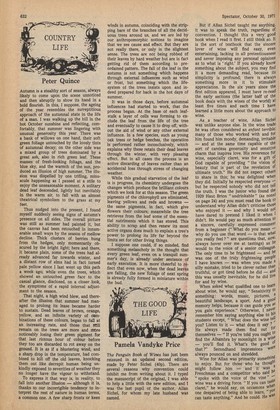COUNTRY LIFE Peter Quince
Autumn is a stealthy sort of season, always likely to come upon the scene unnoticed and then abruptly to show its hand in a bold flourish. In this, I suppose, the ageing of the year resembles the surreptitious approach of the autumnal state in the life of a man. I was walking up the hill in the hot October sunshine and reflecting, comfortably, that summer was lingering with unusual generosity this year. There was a bank of willows on one hand, their soft green foliage untouched by the lovely tints of autumnal decay; on the other side was a mixed group of trees dominated by a great ash, also in rich green leaf. These masses of fresh-looking foliage, and the blue sky, and the warmth of the sun, produced an illusion of high summer. The illusion was dispelled by one trifling, minuscule happening as I paused at a stile to enjoy the unseasonable moment. A solitary dead leaf descended, lightly but inevitably in the warm air, to fall with an almost theatrical symbolism to the grass at my feet.
Thus nudged into the present, I found myself suddenly seeing signs of autumn's presence on all sides. The overall picture was still as summer had painted it, but the canvas had been retouched in innumerable small ways by the season of mellow decline. Thick clusters of berries hung from the hedges, only momentarily obscured by the bright light; here and there, it became plain, some of the trees had already advanced far towards winter, and a distant row of elms had in fact turned pale yellow since I last went up this path a week ago; while even the trees, which showed an untouched green face to the casual glance, disclosed, on a closer look, the symptoms of a rapid internal adjustment to the season.
That night, a high wind blew, and thereafter the illusion that summer had managed to prolong its lease became harder to sustain. Dead leaves of brown, orange, yellow, and an infinite variety of aimbinations of these colours, began to fall at an increasing rate, and those that still remain on the trees are more and mere noticeably losing their green pigment for that last riotous hour of colour before they too are discarded to rot away on the ground. It is as if a blustering wind, and a sharp drop in the temperature, had combined to kill off the old leaves, knocking them out like decrepit human being unkindly exposed to severities of weather they no longer have the vigour to withstand.
To express it that way is, in reality, to fall into another illusion — although it is, thanks to our incorrigible tendency to interpret the rest of nature in human terms, a common one. A few sharp frosts or keen winds in autumn, coinciding with the stripping bare of the branches of all the deciduous trees around us, and we are led by our anthropomorphic notions to imagine that we see cause and effect. But they are not really there, or only in the slightest sense. The trees are not being robbed of their leaves by hard weather but are in fact getting rid of them according to preordained pattern. The fall of the leaf in the autumn is not something which happens through external influences such as wind or frost, but something which the lifesystem of the trees insists upon and indeed prepared for back in the hot days of summer.
It was in those days, before autumnal influences had started to work, that the process began. At the base of each leafstalk a layer of cells was forming to exclude the leaf from the life of the tree and eventually to cause it to drop off, without the aid of wind or any other external influence. In a few species, such as young oak trees or hedge beeches, the operation is performed rather inconclusively, which explains why these retain their dead leaves through the winter, with very pleasing effect. But in all cases the process is an active discarding of leaves rather than an accidental loss through stress of changing weather.
While this gradual starvation of the leaf is is progress, its chemistry undergoes the changes which produce the brilliant colours which we look for at this season. The green pigments of the chlorophyll are eliminated, leaving yellows and reds and browns — the same pigments, in fact, which give flowers their colours; meanwhile the tree retrieves from the leaf some of the essential nutriments which it has stored. This ability to scrap and then renew its most active organs does much to explain a tree's power to prolong its life far beyond the limits set for other living things.
I suppose one could, if so minded, find something melancholy in the thought that every green leaf, even on a tranquil summer's day, is already under sentence of early execution. It is more cheerful to reflect that even now, when the dead leaves are falling, the new foliage of next spring is already fully formed in miniature within the bud.


































 Previous page
Previous page